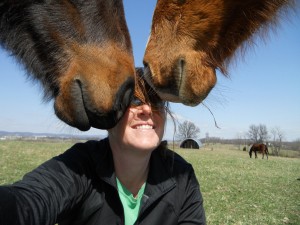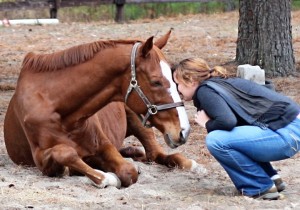A national ex-racehorse charity has begun its own herd-health evaluation in the wake of a New York Times story that reported some retired racehorses were starving in the care of another well-known organization.
Shortly after the Times reported in a May 17 article that 34 horses under the care of the Thoroughbred Retirement Foundation (TRF) were emaciated or in poor condition, volunteers at the Communication Alliance to Network Thoroughbred Ex-Racehorses (CANTER) ratified an initiative to improve transparency, and reassure the public that horses in CANTER’s care are doing well.
“After the Times article came out, we started getting phone calls from people who we’d never heard from before. Some people never call after they donate a horse. But we received a flurry of inquiries from people who wanted to know if their horse was alright,” says national CANTER board member and Canter Mid Atlantic Executive Director Allie Conrad.
To reassure these callers and the greater public that horses in their care receive the utmost care, CANTER ratified a Herd Health Initiative requiring thorough veterinarian screening of all 120 horses every six months.
Veterinarians will file a report every time, detailing the diet and overall physical condition of each horse, making comments on hoof, teeth and body health. When necessary, they will also suggest improvements.
The reports will be published on CANTER chapter websites.
“The Thoroughbred owners and trainers have entrusted us with their ex-racehorses, and our supporters have entrusted us to spend funds wisely,” she adds. “We take that trust and responsibility very seriously… and we want them to know that we’re not hoarding horses, or putting skinny horses out in a back field.”
In fact, according to CANTER, they only accept ex-racehorses who are suitable for retraining into a second career. This further differentiates what CANTER does in the spectrum of horse charities, which range from organizations that only take retirement horses, to those who bring in horses for retraining and sale.
“Our horses have to be sound for a second career and placeable,” says Conrad.
When horses arrive into CANTER’s care, they receive a full medical evaluation and are put on a plan, which includes meeting nutritional needs, the proper amount of time to let down after a race career, and retraining, Conrad adds.
Conrad is passionate in her love of ex-racehorses.
Twelve years ago, she bought Clever Ma, now named Phinny, at the New Holland auction. Since then, the pair has experienced great joy riding events, foxhunts, and trails—he does everything she ever asked of him.
Phinny is a constant reminder of why she believes so strongly in CANTER’s mission to find new jobs and homes for ex-racehorses. Somebody’s forgotten racehorse can achieve great things in another career, she says, noting that many top-level horses used to race. And famous equestrian Laine Ashker is doing great things on her CANTER alumn, Anthony Patch.
“Anthony Patch was skinny and spindly when he was discovered and bought for $500,” she says.
Stories like Patch’s and Phinny’s abound, reminding Conrad that though a difficult news story may cause concerns, it also creates opportunity. In this case, the chance to highlight how well the herd is faring.
“This new initiative provides a good opportunity to engage with people and demonstrate that we are spending responsibility to uphold our duty to the horses and the people who support us.”




